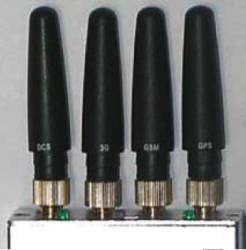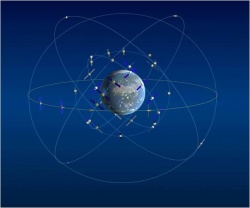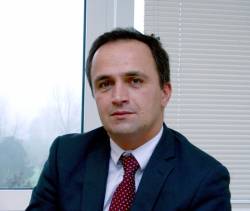 Peter Gutierrez
Peter GutierrezGalileo promoters have always tended to try to link the program to new jobs and economic growth, arguing that once Europe’s global satnav system is up and running, new services will be possible and opportunities for EU companies will abound.
Such arguments needed to be made, to bolster the chronically tenuous political support Galileo has garnered from the European Union (EU) powers-that-be and the chronic lack of faith among just about everybody in Europe’s ability to actually make the system fly.
Galileo promoters have always tended to try to link the program to new jobs and economic growth, arguing that once Europe’s global satnav system is up and running, new services will be possible and opportunities for EU companies will abound.
Such arguments needed to be made, to bolster the chronically tenuous political support Galileo has garnered from the European Union (EU) powers-that-be and the chronic lack of faith among just about everybody in Europe’s ability to actually make the system fly.
Need proof of that last point? As we speak, Galileo is moving into its critical final deployment phase and its budget is still being hashed and rehashed in the capital city’s back rooms.
To be sure, Europe is pushing hard not to disappoint with its latest Galileo program promises, bending over backwards to keep satellite launches on schedule and sticking tenaciously to its 2014 timeline for initial services.
But industry insiders, even in Europe, have always known that you don’t need Galileo to make money and create jobs in the GNSS universe. And for many, the center of that universe is moving rapidly towards Asia.
Cautious Hopes
Septentrio Satellite Navigation NV, based in Leuven, Belgium, is a designer and manufacturer of high-end multi-frequency GNSS receivers, providing receiver boards for system integration by original equipment manufacturers (OEMs).
Jacques Borremans heads Septentrio’s China office in Beijing. As such, he’s on the front line in Europe’s battle to win its share in one of the most promising markets in the world. But selling EU small/medium-sized enterprise (SME) know-how in what some would consider a hostile industrial and political environment is not easy.
Asked how he views the potential for real agreements between EU and Asian businesses, he says, “Past experience has shown that binding agreements for joint ventures are all in the realm of the imagination. This is especially true for small and medium-sized companies that don’t have deep pockets, extended periods of negotiation time, and tools to protect their intellectual property on an international level.”
He adds, “Combining high tech know-how with fleeting expiry dates, a weak legal enforcement environment, and different cultural mindsets, any agreement will allow loopholes to flourish rapidly.”
Then again, China might not be as hostile today as it seemed yesterday. Borremans says the country’s release of a complete Interface Control Document (ICD) for the BeiDou B1 civil signal last December represents a new opportunity, enabling European companies to design multi-GNSS receivers with BeiDou/Compass capability.
“Septentrio has already successfully implemented the BeiDou B1 capability on its receivers,” he confirms. “We expect that in due time the ICD for B2 will be released, allowing full Compass capability.”
Septentrio is just one of a number of European companies that are not waiting around for Galileo. Rainer Horn of SpaceTec Partners says, “We are living in a multi-GNSS world, where all of these systems — GPS, GLONASS, Compass, not just Galileo — represent opportunities for Europe.”
GNSS.asia
Septentrio and several other European companies are taking part in the GNSS.asia initiative, which is coordinated by SpaceTec Partners. Funded by the EU, GNSS.asia is designed to seek business opportunities, promote trade, and launch cooperative industrial projects between European and Asian companies. Target economies include China, India, Japan, the Republic of Korea and Taiwan.
As the initiative’s coordinator, Horn describes GNSS.asia as “a matchmaking process” and says he hopes to define a clear industrial cooperation strategy for the European Union and the five Asian economies.
Launched in January 2012, GNSS.asia first identified European companies interested in cooperation and then went after industrial and institutional stakeholders in the targeted Asian nations.
“We have identified a group of European companies and the same in Asian partner economies,” Horn says. “Following our recent EU-Asia Satellite Navigation Industry Seminar in Brussels, and with the continuous effort of our Asian partners to engage their local companies, we have managed to open up direct interactions between European and Asian companies.”
Most recently, the initiative has targeted what may be the toughest nut to crack — China. Borremans, who gave a keynote speech at GNSS.asia’s recent workshop in China, says all sides seem to be exhibiting similar amounts of enthusiasm and skepticism. “Everyone wants to cooperate, exchange knowledge, and ideas,” he says. “The key to this puzzle always remains how this is translated into a sustainable long-term win-win situation.”
Culture Is Key
But what about the deep cultural differences that hinder understanding and trust between EU and Asian partners? Borremans says, “Cultural barriers are the greatest deal breakers because both partners come with their own set of values and habits.” As a result, more often than not, misunderstanding and mistrust are encapsulated in oral and written agreements.
Borremans says Europeans often look for long-term cooperation with fast access to a potentially large market while Asians more often value knowledge transfer and medium-term cooperation periods.
“Rapid progress is a concept that will be looked upon by both parties from a completely different time frame, different result-oriented expectations, and dissimilar estimations of value of goods or knowledge exchanged,” he says. “To elegantly juggle those requirements is an art that can only be balanced out if both parties are willing to cross the cultural divide in a sincere way and have deep pockets to pay for an organization that can sustain such openness.”
Horn agrees that bridging the cultural gap can be a key to success. “A complete understanding of cultural specificities and professional ethics is indeed critical for cooperation between EU and Asian partners.”
He says that GNSS.asia’s consortium, with both European and Asian expertise, is up to the task.
Win-Win?
Horn believes that GNSS.asia is particularly helpful to SMEs who do not have the resources to deploy permanent agents or staff in Asia.
He cites the example of the CEO of an SME from the Eastern Europe who “recently prepared himself with advice from our European and Asian partners before setting off on a Business trip to East Asia,” adding, “Meanwhile, we have a German company with previous activities in India looking at possibilities further east. We hope to plant more seeds like this over time.”
East Asia is a hotspot in many ways — as a huge market in itself, as a supply market, and a uniquely positioned region for GNSS signal density.
“The area covered by the project is the best place to reap the benefits in the upcoming multi-GNSS era,” Horn says. But, “Each economy poses different challenges and presents different opportunities. In countries with regional or global satellite navigation systems, the valorization of Galileo relies to some extent on synergies with those systems.”
Another important factor is the nature of the industrial sector, whether it is more SME-driven or controlled by large enterprises. GNSS.asia is mapping the differences with the goal of fashioning a tailored approach to the various markets.
The 500-Pound Gorilla
With China making rapid progress on its BeiDou system and now a real competitor in the global GNSS market, is there a sense of urgency on the part of Europe to ensure that the EU GNSS industry remains relevant to Asian markets?
Horn says, “This is clearly about opportunities and learning about the demand and supply side in important dynamic markets. Personally, I am convinced that there is an interesting positioning for Galileo as the only civil system. This will be recognized by industrial partners.”
But the Galileo program also comes to Asia with baggage. Memories of the Galileo-China debacle remain a thorn in the side of good relations (discussed previously in this column in the July/August 2012 issue of Inside GNSS).
Just how is GNSS.asia dealing with problematic history of China/EU cooperation in GNSS? In China, at least, by not dealing with it.
Horn explains, “We are focused on downstream business, that’s our mandate, which allows us to sidestep the whole Galileo-China question.”
The recent GNSS.asia workshop in Beijing, where Borremans delivered his keynote speech, brought together about 60 industrial participants, which Horn believes is a real accomplishment, even something of a record.
And with ongoing discussions and handshaking between the European Commission’s chief of space activities Paul Weissenberg and Chinese counterparts, it looks like China really is back at the table.
Rosy though the picture may be, touchy political terms remain to be parsed, such as, for example, GNSS.asia’s diplomatically correct referencing of Taiwan as an “economy” and not a “country”.
Says Horn, “We have to be sensitive. We have to be careful about how we use words. The mere mention of Taiwan as a separate entity, for example, raises eyebrows in some parts of the world.”
Daily Chinese
Chinese Daily, the country’s English-language newspaper, met the Beijing GNSS.asia event, which hap-pened to coincide with a big International Committee on GNSS event (ICG-7) across town, with a veritable barrage of satnav-related articles, extolling the virtues of China’s GNSS program.
Hard to say just how much encouragement the publication received from the Chinese government, but no one has any doubt about the level of political influence exerted over all of China’s media. On the other hand, although the sudden burst of coverage was unusual and obviously timed to impress foreign guests, one cannot argue that it was simply propaganda. The message that it sent is basically true: Chinese GNSS is kicking butt.
Nor, it would seem, is China in any way intimidated by a European foot in its door. In one Chinese Daily article, Cao Hongjie, vice-president of Beijing UniStrong Science and Technology, was quoted as saying, “We also welcome international companies to develop devices and services for users based on BeiDou; we welcome the competition brought by foreign companies.”
Although control of the media is widely recognized — and, therefore, Mr. Cao’s message must be considered officially OK — the Chinese government’s role must also be considered. Chinese companies, especially the “important” ones, often have an element of state ownership, either explicitly or in the background.
Horn acknowledges that distinguishing true, private entrepreneurial companies from more state-influenced business entities can be tricky, but Chinese companies are truly looking for opportunities beyond those offered by the homegrown BeiDou program, he adds.
China’s domestic applications market will remain a tough nut to crack for foreign players as the government prescribes the use of the local system, similar to Russian initiatives with GLONASS.
For example, in January China’s transport authorities announced that certain commercial vehicles in some regions are now required to use the homegrown BeiDou system. In recent years, Russia has attempted to implement GLONASS carriage requirements for commercial aircraft flying in its domestic airspace and proposed tariffs on GNSS receivers imported into the country that lack GLONASS capability.
No Diminishing of Galileo
When Horn says GNSS.asia is sidestepping the Galileo question, it certainly does not mean that he and others in the European GNSS industry are trying to distance themselves from Galileo.
“It’s obvious,” Horn says. “If we can sell a handheld device to a Chinese distributor using BeiDou, this means jobs for Europe.”
But he also says, “The project can potentially be strategic for European GNSS.” Again, one of the project’s specific aims is to raise awareness in Asia about Galileo and the Europe’s satellite-based augmentation system (SBAS), EGNOS. The EU is clearly seeking cooperation on issues such as standardization, interoperability, and compatibility.
Speaking at a recent GNSS.asia industry event in Brussels, Septentrio CEO Peter Grognard noted the importance of underlining to Asian stakeholders the world-class services offered by Galileo, which will exceed most mission requirements and enable a variety of improved or new applications.
Horn says, “There are several applications that rely on superior performance that only Galileo will be able to deliver. But for Galileo to succeed in the global market, chipsets and receivers — which are mainly produced in Greater China, Japan, and Korea, by the way — need to be Galileo-enabled.”
Moreover, he says, “Europe is known to excel in innovative solutions, which our individual companies can bring to Asian markets.” In the case of SBAS systems, for example, Europe already has EGNOS, which is fully operational. European know-how on SBAS-related applications is therefore relevant for many Asian companies.
Horn’s fellow GNSS.asia co-coordinator Daniel Ludwig, also speaking at an event in Brussels, underlined the role of the European Commission as a public partner in Galileo, and of the European GNSS Agency (GSA) in the development of applications.
“This is essential, for both the credibility of the schedule of delivery of services, and for the political impact of the cooperation on industry,” he said. “Ten years ago, we had to convince people that we needed Galileo. Now that we have proof that Galileo can offer high-quality services, we should show people the opportunities available to businesses.”
Jacques Borremans agrees. “GNSS.asia serves the wider EU policy of establishing Galileo as a globally accepted system/standard for GNSS-based positioning and navigation,” he says, at a time when the Galileo program has implemented the in-orbit validation phase and is commencing the deployment of fully operational satellites.
Adds Horn, “As far as we know, GNSS.asia represents the first time that EU-Asia industrial cooperation in GNSS is being pursued in a consistent way across economies. We are trying our best to contribute to the positioning of European GNSS in the global marketplace and supporting European industry in this field.”
But again, he insists, it’s about multi-GNSS, not just Galileo.
We tend to agree. It never has made any sense for anyone, let alone Europeans, to sit on their hands waiting for a pot of gold to appear at the end of the Galileo rainbow.
Whether or not Galileo itself ever manages to live up to expectations, the rest of the GNSS world is moving forward rapidly, especially in Asia. The jobs are there now, up for grabs.





